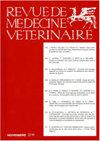Diversidad genética de palomas domésticas (Columba livia) en Ciénaga de Oro (Colombia), utilizando genes del plumaje
Q2 Veterinary
引用次数: 1
Abstract
This study aimed to evaluate the genetic diversity of domestic pigeon populations ( Columba livia ), using genes that are responsible for encoding plumage color and design, in Cienaga de Oro (Cordoba, Colombia). Random samplings were performed in 5 colonies of Cienaga de Oro from June to August 2015. By means of urban excursions, direct observation and photographic records, 325 pigeons were studied. Autosomal markers encoding plumage color and design were used: Grizzle (G), Spread (S), Checker (C), and the sex-linked Ash-Red locus (B). Genetic parameters—allele frequency, genetic diversity, Hardy-Weinberg equilibrium, and population structure—were calculated using the PopGene 1.31 program. Genetic structure and genetic distance were evaluated using the FSTAT v. 2.9.3.2 program. A dendrogram was elaborated using the MEGA 5.2 program. The marker with the highest allele frequency was Spread , while the Ash-Red marker showed the lowest values. Little genetic differentiation between populations and high gene flow were obtained. An excess of heterozygotes was observed, in addition to the absence of Hardy-Weinberg equilibrium. A possible natural selection for the Spread marker was evidenced.cienaga de Oro(哥伦比亚)家鸽(Columba livia)的遗传多样性,利用羽毛基因
本研究旨在利用负责编码羽毛颜色和图案的基因,评估哥伦比亚科尔多瓦Cienaga de Oro地区家鸽种群(Columba livia)的遗传多样性。2015年6 - 8月对5个Cienaga de Oro种群进行随机抽样。采用城市考察、直接观察和摄影记录等方法,对325只鸽子进行了研究。使用常染色体标记编码羽毛颜色和设计:Grizzle (G), Spread (S), Checker (C)和性别连锁的Ash-Red位点(B)。遗传参数-等位基因频率,遗传多样性,Hardy-Weinberg平衡和群体结构-使用PopGene 1.31程序计算。利用FSTAT v. 2.9.3.2程序对遗传结构和遗传距离进行评价。利用mega5.2程序编制了树状图。等位基因频率最高的标记为Spread,等位基因频率最低的标记为Ash-Red。群体间遗传分化小,基因流高。除了没有Hardy-Weinberg平衡外,还观察到杂合子过多。证明了扩散标记可能存在自然选择。
本文章由计算机程序翻译,如有差异,请以英文原文为准。
求助全文
约1分钟内获得全文
求助全文
来源期刊

Revue De Medecine Veterinaire
农林科学-兽医学
CiteScore
1.30
自引率
0.00%
发文量
0
审稿时长
18-36 weeks
期刊介绍:
The Revue de Médecine Vétérinaire publishes four kinds of text:
1) Scientific reviews on subjects related to veterinary and comparative medicine. Suggested length: 10 to 30 typed pages.
2) Original reports on fundamental or applied research. Suggested length: 10 to 15 typed pages.
3) Continuous education articles, that should be easily understandable by non-specialists. Suggested length: 10 to 15 typed pages.
4) Clinical reports. Suggested length: 5 to 15 typed pages.
The publication can be done in French language or English language.
For an article written in English by not english native speakers authors, the manuscript must be subjected by attesting that it was read again by an anglophone scientist or a scientific translator.
The authors must certify that the manuscript was not published or subjected for publication to another review.
The manuscript must be accompanied by a sheet signed by all the joint authors indicating their agreement for the tender of the manuscript.
The publication is free but a financial participation could be required for the photographs color. An estimate will be sent to collect the agreement of the authors.
 求助内容:
求助内容: 应助结果提醒方式:
应助结果提醒方式:


